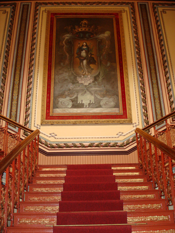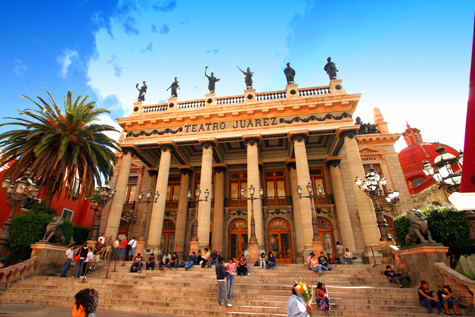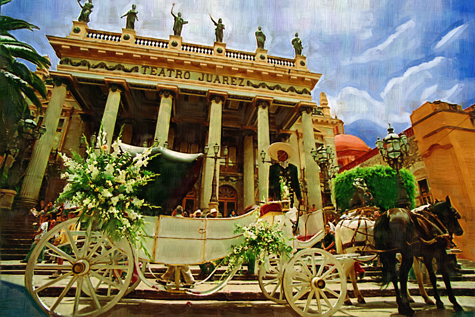
28 Nov 2007
Guanajuato Opera a document of Mexican history
What makes the first visit to Guanajuato’s Teatro Juárez breathtaking is the suddenness of the encounter.
English Touring Opera are delighted to announce a season of lyric monodramas to tour nationally from October to December. The season features music for solo singer and piano by Argento, Britten, Tippett and Shostakovich with a bold and inventive approach to making opera during social distancing.
Conductor Oliver Zeffman has commissioned the very first opera for a socially distanced world, which is now available to watch exclusively on Apple Music. Eight Songs From Isolation has been written by eight leading composers, specifically for streaming - rather than live performance - and is the first opera written for a time when the performers were unable to meet in person.
Leading freelance musicians unite in Parliament Square to call for targeted support for colleagues in the arts and entertainment sector.
Duo Lewis Murphy (composer) and Laura Attridge (writer) have launched a charitable song project entitled Notes From Isolation. The resulting songs, featuring some of the UK's top singing talent, are being released online between August and October 2020 and can be enjoyed free of charge.
The Royal Opera House is thrilled to announce an exciting, wide-ranging new line-up for its autumn programme. For the first time, extraordinary performances will be accessible online for a global audience through livestreams and for socially distanced live audiences at our home in Covent Garden. In a global first, we present a new opera in hyper-reality, alongside repertory favourites from both artistic companies.
Some of the most famous and outstanding stars from the opera world are to take part in a very special evening from Wexford Festival Opera, including Aigul Akhmetshina, Joseph Calleja, Daniela Barcellona, Juan Diego Flórez, Igor Golovatenko, Ermonela Jaho, Sergey Romanovsky, and many more.
Following its successful launch in 2019, OperaStreaming streams nine operas on YouTube from the historic opera houses of Emilia-Romagna during the 2020-21 season, with fully-staged productions of Verdi's La traviata in October from Modena and Verdi'sOtello from Bologna in...
‘A brief history of song’ is the subtitle of the 2020 Oxford Lieder Festival (10th-17th October), which will present an ambitious, diverse and imaginative programme of 40 performances and events.
Bampton Classical Opera returns to the Baroque splendour of London’s St John’s Smith Square on November 6 with a concert performance of Gluck’s one-act opera The Crown, the first in the UK since 1987. The performance will also be filmed and available to watch on demand on the Bampton website from 9 November.
While many of us spent lockdown at home taking it a little easier, composer Andrew Synnott wrote an opera.
Owen Wingrave is part of the new Interim Season of 19 brand new events, all free to view online between September and December 2020.
The Arts Council has awarded innovative UK charity Music and Theatre For All (MTFA) a major new grant to develop three ambitious new projects in the wake of Covid 19.
English National Opera (ENO) will reopen the London Coliseum to socially distanced audiences on 6 and 7 November for special performances of Mozart’s Requiem. These will provide audiences with an opportunity to reflect upon and to commemorate the difficulties the nation has faced during the pandemic.
The Royal Opera House is proud to continue its curated #OurHouseToYourHouse programme into the autumn, bringing audiences the best of the ROH through a new series of Friday Premieres and cultural highlights.
After six months of closure, the Royal Opera House is thrilled to be opening its doors to the public as part of Open House London weekend, giving visitors a taste of one of the world’s most famous theatres for free.
The Academy of St Martin in the Fields is thrilled to announce re:connect - an eight concert series with live socially distanced audiences at its namesake church, St. Martin-in-the-Fields. The autumn concerts will take place at 5pm & 7:30pm on two Saturdays per month with guest artists including baritone Roderick Williams, soprano Carolyn Sampson and composer-conductor-pianist Ryan Wigglesworth performing a wide range of repertoire.
Music and poetry unite and collide across centuries, from the Medieval to the Enlightenment to the present day. This year, the Oxford Lieder Festival will present a thrilling and innovative programme comprising more than forty events streamed over eight days.
The English Concert with artistic director Harry Bicket is delighted to announce a series of concerts from 1-15 October 2020. The concerts take place in historic London venues with star soloists and will be performed and streamed live to a paying audience at 7pm GMT on each performance date. The programmes include first-class vocal and instrumental works from the two pillars of the English Baroque, covering different aspects of the repertoire.
Glyndebourne has announced plans for a ‘staycation’ series of socially-distanced indoor performances, starting on 10 October 2020.
The Royal Opera House is delighted to announce two packed evenings of opera and ballet, live from our stage in Covent Garden and available to view wherever you are in the world online.

What makes the first visit to Guanajuato’s Teatro Juárez breathtaking is the suddenness of the encounter.
The structure, inaugurated in the once-rich mining town in 1903, fronts on a busy, narrow street. There is no square that allow a grand vista; indeed, the Juárez is best approached obliquely from the Jardin Union, the long rectangular square to its right with classically trimmed trees, wrought-iron band shell and outdoor cafes, where strolling mariachi musicians play. Only there can one pause and absorb the grandeur of the Romanesque facade with its gentle broad stairs and Doric columns topped in bronze. One’s eyes move up to the eight, copper-cast Hellenic muses that top the portal.
“Eclectic” is the word encountered everywhere in descriptions of the theater’s style. One enters a French lobby, for Paris’ Garnier was in the mind of Jose’ Noriega, the original architect. By comparison, of course, the Juárez is happily modest. There is no grand staircase after European models, but a stairs on the right of the lobby that ascends directly into the Green Room across from the first of four balconies.Opposite these stairs is the smoking room with hints of Art nouveau in its stained glass and handsome woodwork. Originally a retreat for men only, today it offers refreshments to all — and still tolerates smokers.
Up a small flight of stairs from the lobby, one enters the auditorium, a showpiece of multi-colored splendor, where Moorish arches frame the proscenium boxes. One looks up to the top of the horseshoe balconies to a six-pointed crystal chandelier that sheds subdued radiance on the 850-seat auditorium. The coming of Christianity to Constaniople is the subject of the huge painting on the fan above the stage. In words this mix — “eclectic” seems an understatement — might suggest a Disneyland hedge-podge, but in the Juárez it works — and works magnificently. One can sort out the stylistic components, but there is no temptation to do so. They flow easily into each other to blend in an esthetically pleasing whole.
Enrique Carlos Greenwell Castillo, a Guanajuato-born architect specializing in historic preservation, has been involved in the Jua’rez since 1953. Then 19, he helped paint interior walls to resemble the original wall paper. “The theater is a document of Mexico’s history, and you can’t understand it without knowing that history,” Castillo said one October morning in his studio in the heart of Guanajuato. “Napoleon, Emperor Maximilian II, Juárez — they were all involved in events leading to its construction.”
The 19th century was a turbulent time in Mexico, when — as Castillo summarizes — either Mexico was being invaded by someone or the country was caught up in civil war. A turning point was the declaration of the republic following the execution of Maximillian in 1865.“Eight years later things had stabilized,” Castillo says, “and that was when one first thought of honoring Juárez with a world-class theater in Guanajuato. “It was clear from the beginning that it would bear his name.”
Although Juárez, then president of the republic, was busy running from both the French and the Austrians, he spent some time in Guanajuato and for a few weeks made it his capital. “Modern Mexico was born in the 1880's,” Castillo says. “And it was a time of economic revival, in which a lot of theaters were built. “It was also a time when French culture dominated in the country, and this was a major influence on the original design of the Juárez.”

Cornerstone of the theater was laid in 1873 and work began on Noriega’s plans. Two years later work was suspended and then resumed in 1892, plans now revised by Antonio Rivas and Alberto Malo, who opted for greater ostentation in the building. “They were not architects!” Castillo laughs. “They were mining engineers.”
The Juárez finally opened on October 27, 1903, with the performance of “Aida” by a visiting Italian company. “It could have opened a decade earlier,” Castillo says, “but they had to wait until Porfirio Diaz could attend. “It took him 10 years to get here.” Diaz, the major heir of Juárez, was Mexico’s president — with a brief interruption — from 1876 to 1911.
Hard times descended on Guanajuato soon after the opening, and for decades the Juárez was used — Costillo points out — as everything but a theater. “It’s a sad story,” he says, “and it went on for almost 100 years.”
“In 1912 it was leased to a private company for movies — for silent films, but it went bankrupt in a few years,” he says. “It was a ballroom, a circus and a place for wrestling and boxing matches. “Political assemblies, pop concerts and local festivities brought in crowds that had no respect for the building. It continued to deteriorate.” In 1949 the Juárez again became a cinema, and Costillo recalls seeing films there when he was a boy.
“By 1957 it was a ruin, and the cinema’s lease was not renewed. The Juárez was turned over to the University of Guanajuato, founded in 1732 and long one of Mexico’s most respected schools. Influenced by the reconstruction of historic buildings in war-devastated Europe, the 50's brought renewed interest in the theater. In 1964 a congress of architects met in Italy and issued the “Venice Charter” that called for the conservation and restoration of historic buildings, monuments and sites everywhere. “Inspired by reconstruction in Europe, the charter was like a new Ten Commandments for us,” Costillo says. “But work was undertaken with no special criteria.”
It was in 1953 that Costillo had became actively involved in restoration of the Juárez. He his task then was painting the auditorium walls in the ornate pattern of wallpaper that could not be replaced in kind. “It had been stripped away in bits and pieces by movie-goers,” Costillo says.
In 1951 the University had organized the city’s first full symphonic ensemble and moved its concerts to the Juárez. It was, however, the launching of the Festival International Cervantino in Guanajuato that finally brought about the full rebirth of the Juárez. Although a contemporary of the conquistadors, Miguel de Cervantes didn't make it to the New World — at least not during his lifetime. In the past half-century, however, he has become a living presence in Guanajuato, now a city of 200,000. The author of “Don Quixote” first “arrived” there — so to speak- in 1953, when students at the university began outdoor performances of his short farcical plays known as “Entremeses.”

It was on that tradition that the Mexican government in 1972 founded the Cervantino, which staged its 35th season in October. It is Mexico’s major arts festival and one of the major artistic events in all of Latin America. “Don Quixote is the icon of this city,” general and artistic director Irma Gabriela Caire Obregón says, pointing to the 800 items in the local Quixote Iconographic Museum. “He is an adopted local son, the 'good fairy' of the festival.” (A heavy bronze plaque in the lobby of the theater celebrates 1972 of “the Juárez year,” celebrating the man who — as Costillo says - “was Mexico’s Abraham Lincoln.”)
“Local pride in the theater revived,” Costillo says, “but there were a lot of problems. The building had to be brought up to code in safety standards. “There were no emergency exits. The original furniture was gone, and wood had rotted. “The building was falling down!” A new wave of reconstruction was launched — under Costillo’s supervision — in 1989. “The muses above the entrance had rusted and were replaced,” he says. “Wood was restored; structural improvements were carried out — along with an up-grading of the electrical system.Something major is done every year; for 19 years the government has invested a significant amount of money in the Juárez. “The masonry of the building, having withstood major floods, is sound, and insects do not like the red pine of the roof!”
And although he does not work directly with the Cervantino, he shares the festival’s commitment to the Juárez. “We are constantly in touch,” he says, underscoring his admiration for Caire. For Caire, named to her post early in 2006, the Juárez is one of the most beautiful theaters in Mexico. “We want to stage more events there,” she says, “but it’s an old theater, and there are limitations on what we can present.”
If the Juárez long suffered from an absence of the art for which it was intended, rich compensation has come through the Cervantino. In 1980 Beverly Sills sang Rosina in “Barber of Seville” there. Birgit Nilsson, Aprile Millo and Dmitri Hvorostovsky have sung on its stage, and Yehudi Menuhin has played there. Leonard Bernstein and Mstislav Rostropovich have conducted visiting orchestra, while the Kronos, Cleveland and Kodaly Quartets have played chamber music in the theater.
Although at present the Juárez is little used outside the Cervantino season — the University’s orchestra now plays in the near-by Teatro Principal — Costillo tells of an annual event central to the life of the city. And one is awed by the celebration there of what Americans know as Halloween. “Every year on November 1 there is a performance of Jose’ Zorrilla’s ‘Don Juan Tenorio,’” he says. “It’s a tradition that we could not live without.”
Beyond its beauty and its importance as Guanajuato’s finest performing-arts venue is the iconic role of the Juárez in the city. It is in every sense the heart of the community, and on a fresh October evening young people who have never been — and probably never will be — inside the theater sit on its steps enjoying the scene at their feet.
Built on the ruins of a cloister, the Juárez sits today in a pedestrian zone, where countless cafes and street vendors serve a public that seems always in a festive mood — a reflection perhaps of the building itself. In 198 UNESCO designated Guanajuato a World Heritage Zone in recognition of its beauty and culture. The Juárez was no doubt a factor in granting that recognition. (Fans of “Citizen Cane,” by the way, will be delighted to know that actress Dolores del Rio was honorary president of the original Cervantino board.)
Wes Blomster